It’s not always easy to tell when our furry friends are in pain, especially since they can’t tell us what’s wrong. As a loving pet owner, you might feel unsure or even guilty for not noticing signs earlier. But understanding the subtleties of canine discomfort is a learning process, and you’re doing a great job by seeking out this information. In this friendly guide, we’ll explore the different kinds of pain your dog may experience and how they might express this discomfort. Whether you’re in Jacksonville, Ocala, or anywhere else, knowing these signs will equip you to help your beloved pup find relief.
Types of Pain in Dogs
Dogs can experience various types of pain, ranging from acute, such as after surgery or an injury, to chronic, like arthritis or back issues. Recognizing the difference is crucial for providing the right care.
Acute Pain
This is sudden and usually has a clear cause, like a cut paw or an unfortunate encounter with a piece of furniture. Signs of acute pain can include:
– Yelping or vocalizing unexpectedly
– Sudden limping or reluctance to be touched
– Aggressive or defensive behavior when approached
Chronic Pain
Chronic pain can be trickier to detect as it develops slowly and often subtly. It’s common in older dogs or those with ongoing conditions. Signs include:
– Less activity, like reluctance to climb stairs or jump
– Increased rest time, sleeping more than usual
– Subtle changes in behavior, such as increased irritability or depression
Recognizing the Signs of Pain
Each dog expresses discomfort differently, but there are several common behaviors that might indicate your dog is suffering:
- Behavioral Changes
A dog in pain might seem unusually quiet, withdrawn, or even aggressive. If your typically sociable pup starts to isolate themselves or avoids interaction, pain could be the culprit.
- Physical Symptoms
Look for signs such as limping, shaking, or excessive grooming, particularly licking a specific area, which might indicate where the pain is located. Also, watch for changes in posture, such as a hunched back or reluctance to move in normal ways.
- Appetite Loss
Pain can lead to a decrease in appetite. If your dog suddenly seems disinterested in food, consider whether pain might be affecting their eating habits.
- Vocalization
While some dogs become quieter with pain, others may vocalize more. Whining, howling, or even growling can all be signs that something is amiss.
What Can You Do to Help?
Recognizing pain is the first step, but what should you do once you suspect your dog is hurting? Here are some steps you can take:
Consult Your Vet
Always start with your veterinarian to get a professional diagnosis and discuss treatment options. They can provide medications to relieve pain and suggest further diagnostics if needed.
Consider Chiropractic Care
For many forms of pain, especially those related to the musculoskeletal system, chiropractic care can be a fantastic, non-invasive option. An animal chiropractor can help alleviate pain by improving spinal alignment and function, which can have a profound impact on your dog’s overall well-being.
Mobile Chiropractic Services
In places like Jacksonville, Ocala, and other areas, mobile chiropractors are available to come to your home. This is especially useful for dogs that suffer from chronic pain and may have difficulty traveling.
Lifestyle Adjustments
Simple changes at home can make a big difference. Providing a comfortable resting area, using ramps for getting in and out of cars or up to furniture, and adjusting your walking routines to avoid overexertion can all help manage pain.
By keeping a close eye on your dog’s behavior and physical condition, you can catch signs of pain early and take swift action to alleviate their discomfort. Remember, you are your dog’s best advocate and caregiver. Whether it’s through professional veterinary care, exploring options like animal chiropractic, or making their daily life more comfortable, your efforts make a huge difference in your dog’s health and happiness. If you’re in Jacksonville, Ocala, or nearby, plenty of skilled canine and equine chiropractors are ready to help. Your journey with your dog isn’t just about caring for them—it’s about understanding and growing together.

